The ordeal of migrants from Central and South America is a dangerous journey.
Yet, thousands make this trip every year, often with limited, if any food, clothes, money, or water.
Few really understand the ordeals they face like Joel Smith, Director of Operations at Human Borders, a Tucson, Arizona non- profit organization dedicated to taking death out of the immigration border equation.
Joel works closely with property owners to provide emergency water stations throughout desert regions, tracks migrants travel patterns, monitors vigilante groups like the Minutemen, and identifies individuals who have died in the desert in the hopes of finding their family members.
In this live immigration hangout, Joel shares information of the ordeals and agonies faced by migrants in their travels across the U.S. and Mexican deserts. What he shares will likely surprise – and sadden – you, as you gain insights about migrants in the desert.

Here are the main points from the hangout with Joel Smith, streaming live from Arizona, and Carlos Batara, broadcasting live from his Riverside immigration lawyer office located in Hemet, California.
How Joel Smith Became Involved With Immigration Issues
EDITOR’S NOTE: Scroll down to find Joel’s photography collection, capturing the essence of the migrant journey in the desert.
Joel’s involvement began several years ago. Joel was at a Tucson folk festival. One of the performers sang about the situation at the U.S. borders. He mentioned the helicopters flying south, smugglers returning to Mexico, the deaths in the Arizona deserts. Joel was moved by the signer’s words and description of border affairs.
After the concert, Joel contacted the singer. He suggested that Joel reach out to Humane Borders. He arranged for Joel to go on a water run. The singer brought his guitar and as he sang border songs out in the desert, Joel thought about how he wanted to play a role in making the desert a safer place for poor migrants passing through with limited, if any, resources. Joel decided to help Humane Borders. Over time, he was offered a position.
News Coverage About Joel Smith And Humane Borders
Humane Borders was recently featured by a television station in Tucson Arizona. Here is the excerpt.
Water can mean life or death here in the Sonoran desert.
“You can walk for days out here and not find any water springs or wells, just cattle tanks with green algae if you’re lucky,” “This time of year, if you’re lucky, maybe a few mud puddles … from the rains, but this is a desert. There’s no water here.” Ex-marine Joel Smith, is operations manager for ‘Humane Borders’, a non-profit humanitarian organization based in Tucson, Arizona.
He is responsible for filling strategically-positioned barrels with fresh, cool water in the most remote, dangerous areas of the Sonoran desert, where dehydration is the leading cause of death. To people he has never met, he is a life-saving hero, but not everyone agrees.
Arizona is home to a group known as the “Minutemen Project,” – named after the Minutemen militia who fought during the American Revolution. The organization’s members, some of whom are armed, monitor the border to prevent undocumented immigrants from crossing.
The group’s actions have included vandalism and death threats against those willing to help immigrants, says Humane Borders executive director Juanita Molina.
“Unfortunately the militia groups like the minutemen at times vandalize our water stations and vandalize our offices, trying to inhibit this effort, but in reality, you know, our primary purpose is to eliminate death from the immigration equation,”
Besides providing water, Humane Borders also offers basic life-saving information about water barrels and crosses the border to inform migrants of the dangers they face and where to call for help. It’s a messaging initiative that the U.S. Border Patrol has joined to help lower the rate of deaths in the desert.
“The last three years we’ve been right around 200 deaths,” said Pete Bidegain, a spokesman for the U.S. Border Patrol. “This year we have one month left in the fiscal year, we’re right at about 100, so we’re down approximately 44 percent of what we’ve been at in the past. And a lot of that is contributed to messaging efforts that we’ve been putting out in Central America and Mexico”
Even in the harsh Sonora Desert, Joel stays vigilant – regularly cleaning the water barrels and personally testing the water to ensure it remains fresh and cool.
I always tasted the water. “If I don’t like the taste of it, I dump the whole barrel and replace it.”
Together, Joel and Juanita say they are working to save lives, one barrel at a time.
How Border Media Coverage Occurs
Joel is not sure how the story, transcribed above, got started. Typically the Humane Borders office opens at 4:30 – 5:00 in the morning. Joel does not like returning messages at that hour or to work in the office. So he normally heads out to handle the desert work.
On this particular day, a group of reporters accompanied me and the program director to show them the desert.
In Tucson, Humane Borders and immigration issues are old news to the press. They run a story about every couple of years. Basically, his organization’s efforts are old news in Tucson and most people know about their work. There are other pro-immigrant groups in the area, and some people are confused with the differences between them. But all are working for the same goals.
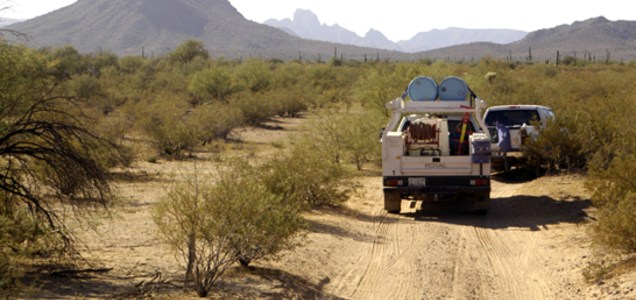
Tucson View Of Immigration Reform Issues
The Tucson media is different than the Phoenix media. In Tucson, the press is generally pro immigration reform. But in Phoenix, they’re very anti-immigrants. It’s like two different worlds and they come into political conflict.
For instance, in Tucson, most of the public was very much against SB 1070, an anti-immigrant bill, when the State of Arizona passed the law a few years ago.
Even though the courts ruled against most of SB 1070, there are still instances where the Tucson Police Department hold immigrants for the U.S. Border Patrol. This has led to people streaming down the streets to try to stop the deportation of immigrants for making a bad right hand turn, an illegal u-turn, or other similar simple offenses, despite the Obama promise to only deport hard core criminals.
Joel Smith’s Perspective Of The Minuteman
Joel is an ex-marine and his father was in the U.S. Air Force. This background leads him to consider the Minutemen and other anti-immigration militia groups in the Southwest as “a bunch of clowns.” He has no respect for them. In his view, good soldiers always follow orders and there have been no orders from the commander in chief to do anything like what they were doing.
Joel does not think many of them have a military or law enforcement background. Based on talking to some of their members, Joel has learned very few have such training. Some were in the infantry, but others who served in the military were in administrative jobs, like cooling or clerk positions. So these are not hard core infantry veterans. That is partly why he thinks they are simply clowns.
Providing Water In The Desert For Migrants
In the news video, Joel states that he can taste the water and based on that taste, he can figure out whether to throw it out or replace it.
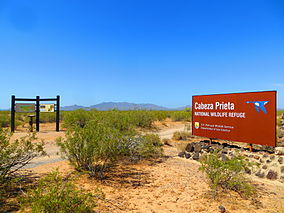
He explains that water does go bad and won’t last too long. He says you can try a water taste experiment at home and you’ll get the sense of what he does. His organization puts up 65 gallon barrels. They fill it up to about 55 gallons of water. It will stay fresh for quite a while.
But this is a large quantity and eventually various organisms will start growing inside. At that point, the water will not taste like normal water. He will dump out the rest of the water still inside the barrel, and fill it up with fresh water. You can do chemical analysis and electronic testing of the water. Joel thinks that just taking a drink of the water is a better test.
He puts out the same size of barrels, 65 gallons, and the same amount of water, 55 gallons, at each station. There is a little bit of air at the top of each barrel. In Arizona, he has about 50 stations. In Sonora, on the Mexico side of the desert, he has about five water stations. He can normally let the barrels go without replacing the water about 60 days. In the summer time, he prefers to change them once a month. The summer heat causes various organisms to come to life. Often, he notes, you can smell them before you reach the water barrel.
Anti-Immigrant Vandalism In The Desert
Humane Borders has not experienced much resistance to the placement of the water barrels. The organization is the most considerate of all the border groups serving migrants, and obtain written permission from every land owner, every property manager, to place barrels on their properties. Joel gets legal documents for each station.
Vandalism to the barrels is a problem. There is also some confusion created by other border groups like the Desert Samaritans, the Queen Valley Samaritans, who leave one gallon jukes of water on the desert trails. Some people confuse their water with that provided by Humane Borders. But they do not have the permission from property owners.
Vandalism to water stations is a bigger draw back to the various groups. Most of Joel’s stations are on the road side. He uses a truck which holds 300 gallons. So he cannot go far away from the road and across the desert, where others can destroy the water jugs without anyone noticing.
Fighting To Take Death Out Of
The Migrant Equation
When Joel first started negotiating with property owners in the area, there was reluctance by some. But some ranchers thought having water barrels was good because it kept migrants from trying to breaking into their wells and water system to find water. With our help, there is a tank of water available to the travelers and they don’t have to do anything but open the valve to get water. There is still some opposition from a few ranchers. Plus, there is resistance from the federal government. But they know, without the help of Humane Borders, a lot more migrants will die out there in the desert.
Joel states those crossing the border carry food with them, but they cannot carry enough water – another reason the water barrels are necessary. Consider, it’s 113 degrees and they have to walk 60-70 miles. You cannot carry enough water to survive. The food you can carry Joel has come across many cactus plants that have been destroyed so that migrants can have water to drink. He has found water packs that have been dumped out, empty. People will share their their food with each other, especially when someone has little or no food. They may be able to go 2, 3, or 4 in some instances without much food, but they cannot go without water that long.
How Long Are Migrants In The Desert?
Joel does not know how long it takes migrants, from places like Guatemala, to get to a U.S. border. Many have taken “the beast,” a big train, across Mexico, but Mexican authorities have clamped down on the riders.
This means many can no longer catch the train from Southern Mexico to Northern Mexico and across the desert into the U.S. They are having to circumvent on foot the Mexican check points. They do the same thing with the American border patrol check points here. But Joel is not sure is how long it takes them and likely varies from migrant to migrant.
For migrants from Mexico, on the average, it’s about 60 miles from Nogales, Mexico to Tucson. If a migrant is in good shape and conditions are perfect, that person might be able to go from the border around Nogales to Tucson in about 3 to 5 days. But as Joel points, most folks are more like him, and it would take a lot longer to complete the journey.
It also depends on where people are headed. For instance, if someone is headed to Phoenix, they circumvent Tucson. They keep heading north, and cross the O’odham reservation and other Native American reservations. This makes their trips longer.
Joel and Humane Borders does not work in this corridor. But Joel thinks they really need to start reaching out in this area because there is a lot of travel in that area. Cochise County in Arizona is not a small area and it increases the migrant’s journey by hundreds of square miles. But as a small non-profit organization, it is impossible to be everywhere at once.
Joel Smith’s Migrants In The
Desert Photo Collection
Joel has documented a lot of the desert migrant equation with excellent photography, deserving of awards. He provided a great deal of the photography shown in an earlier Immigration Live show highlighting Ellin’s Jimmerson’s award-winning documentary, “The Second Cooler.”
Some of his photography is displayed in this hangout – and he describes below:
First Image: This picture was taken in the South Beach area of Sonora, Arizona, located about 200 meters south of the U.S. border. Joel found a doll, which looked like its legs had been shot off or bitten off by one of the stray dogs in the area.
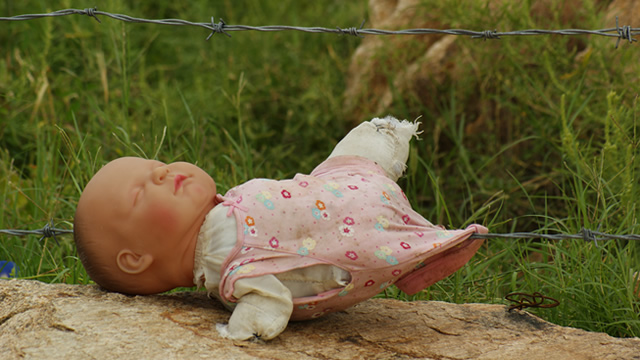
According to Joel, many relics are found are he goes through the desert. He has found, for instance, various baby strollers and little bicycles. Just a few days before this interview, Joel found a cell phone near a water station. Sometimes he finds underwear, undergarments, high hills shoes, family pictures and photographs, fake IDs. He has found many different items in the desert.
Some areas are patrolled by smugglers or human traffickers. South Bay is one such area. South Bay is a town where the only economy is smuggling. It’s an old hide out from the revolution but there is no water there, so owning is not a positive venture. So smuggling has become a means of survival and there are various cartels controlling the area. Joel says he has to be very careful in that area.
It is a port where people pass through. But it is a smuggling ground that people arriving often come from a little town, Altar, roughly 75 miles to the south. They get trucked in to South Bay. After South Bay, they either creep on the east or the west, I’m not sure what they carry before they go.
Second Image: This is a picture of a volunteer checking the water level at one of the stations. It’s one of Joel’s older photographs, taken when he first started working at Humane Borders. The gentleman was checking one of the stations called Coleman Run.
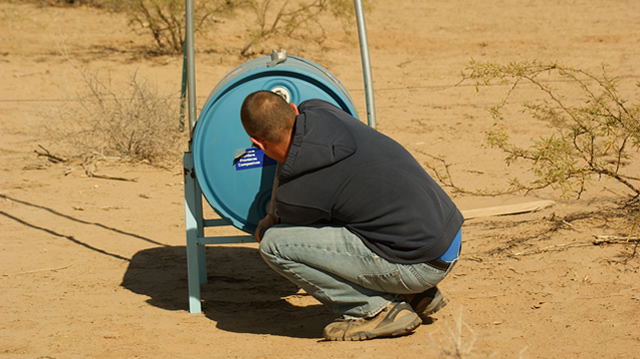
Basically the water level is checked, then the water quality. He has used chlorine strips, but they are unreliable. Joel believes that a taste test is a better gauge of quality. He is willing to also use electronic testing devices because they are also fairly accurate. The goal is to check the quality of the water often enough to ensure the stations remain usable.
Like many others, Joel grew up as a child drinking water out of an outdoor faucet or water hose in the yard during the summer – before people started complaining about the unhealthiness of such practices. In most Mexican towns and villages, however, the water is unreliable. Joel has to do testing to make it’s safe to consume.
Third Image: This photo is a group of young migrants passing through Sonora, Mexico, in the back of a truck.
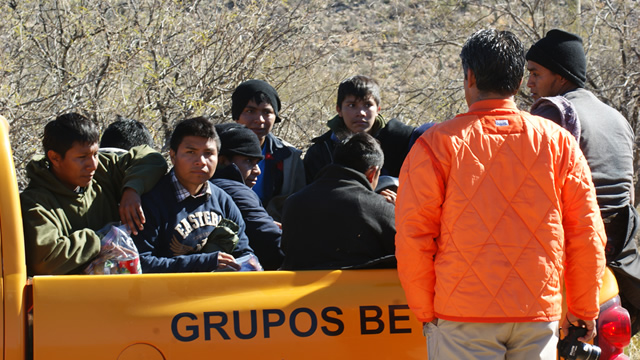
They are members of an organization committed to protecting migrants on the Mexican side . This group patrols the desert looking for migrants in distress. In this photo, the young men appear to be Guatemalans, even though they claimed to be Mexican citizens. One of these fellows looks like he is Asian. At this point of the migrant journey, as migrants approach the border, everyone becomes color blind towards them.
TWEET THIS: As migrants approach the border, everyone becomes color blind towards them.
Migrants do not react with fear or reluctance when Joel tries to take their pictures. Taking photos in Mexico is different than taking photos in the United States. People don’t fear Joel or other photo takers, even in camp grounds.
At some camps, he has been approached by scary-looking guys who shake their heads to leave them alone, and so Joel just waves, smiles, and leaves. If they are okay with their photos being taken, they also let him know.
On the truck, there is a sign, Groupos Beta. This is an agency of the Mexican government. Their job is to go out into the desert and protect the migrants in the Sonora area. They stay on the Sonora side. They do not work with Joel’s organization or other American groups. But Humane Borders has given them various supplies like water barrels, stands, and similar items.
In Joel’s estimate, Humane Borders uses about 600 gallons of water per week during the summer months. In the desert, the barrels are often found empty needing to be replaced.
Joel’s general impression is that the Mexican government doesn’t really care about the migrants. Most of them come from small towns and villages. They really don’t know what they are getting into; they just hear America is a land of a milk and honey, so to speak, and they put themselves in death’s way to be able to find a better life. A lot of them had parents, cousins borrow money from unscrupulous local loan sharks in their home towns and villages.
Joel is aware of claims made by Fusion, a news company, about how much money smugglers make, but has no first hand proof. He has heard rumors, but without being fluent in Spanish, he cannot understand a lot of what they talk about.
He knows that statistics show about 60% of migrant women are raped. Joel has found birth control, condoms, women’s packs in the desert, which shows something is happening. He thinks that crime to migrant women is increasing. It is probably done by smugglers, narcotic runners, and male migrants. Migrant women are at extreme risk.
Image Four: This is the photo of a young man looking at a shrine of an individual, Antonio Rodriguez, who was shot by the Border Patrol.
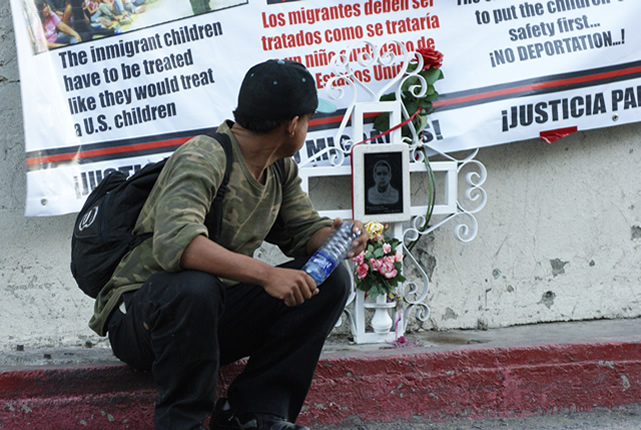
He was shot by 2012 by Border Patrol agents. His mother has sued the U.S. Border Patrol. She wants to find out the names of the agents who shot her son and the real reasons for the shooting. The agency, however, will not release the names. The case will go to trial in about two or three months and the names will likely be made public then.
Joel was involved with the making of the Second Cooler, a film directed by Ellin Jimmerson. The narrative showed how unnamed bodies found in the desert are kept in freezers awaiting identification. Joel prefers not to go to these medical and examiner’s offices. He has not found a dead migrant and hopes it stays that way. Yet, Humane Borders does death mapping. They keep tabs on deaths by geographical areas. This helps them decide where to place water stations as a way to reduce deaths.
Basically, every time the Border Patrol finds a dead body here, they take them to the offices of medical examiners, and they give them GPS points. The medical office releases this information and we are able to track the death. An organization called a Buried Foundation actively tries to determine just the name of the body corpse and why they died. Later, for example, someone from Honduras will call the Mexican consulate. They will discuss identifying body marks, the tattoo on a person’s foreman or the three gold teeth, and then they check their records to find out if the body matches what they know about any missing persons.
Fifth Image: This is a photo of an old smuggling vehicle, located in Cabeza Prieta National Wildlife Refuge. The refuge is located in the Western Arizona region, partly Yuma County and partly Pima County.
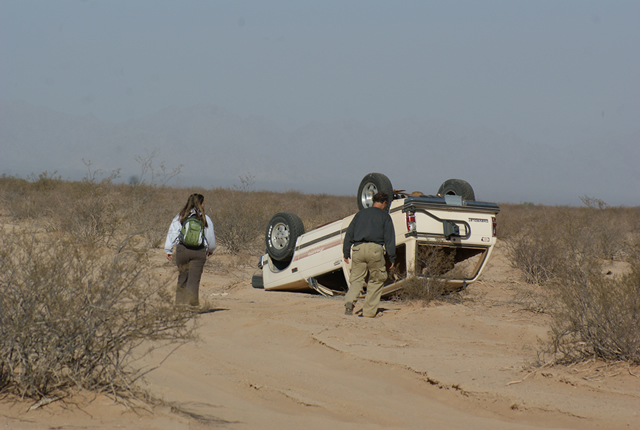
This photo is taken along one of the public use roads, El Camino Del Diablo, or the Devil’s Highway. Joel goes there about once per year to replace game tanks. In this area, you have drug smuggling tied to human smuggling, activity which has been going on very strongly since about 2006.
The photo shows a truck turned over. This is different than the image of smuggling provided by most media sources which are of individuals on foot. Joel says there are people coming in cars through the desert.
The news is straight-laced. In quite a few areas, Joel points out, migrants use quads to transport people and drugs. He has found a lot of trucks hidden in the desert. It would be easy to paint the migrants as the culprits responsible for bringing the drugs in, but this is a small part of the bigger picture. Since 2008, there has only been a small Border Patrol office, with volunteers, in this area and since the agency is crippled, apprehensions are down and amazingly the Border Patrol still seems to be confiscating the same amount of drugs.
Joel sees the U.S. Border Patrol as both a positive and a negative influence on border relations. He thinks most of the public does not understand the Border Patrol is not totally bad, but they do need to be more humanized. There are more patrol agents doing a good job than the agency gets credit for. There are humanitarian types of rescue, whether it’s a helicopter rescue of a migrant stuck on a cliff or a swift water rescue. The problems of the organization is often the wrong 10% doing bad things gets publicity, and they tarnish the whole organization.
A few months ago, a high ranking official was demoted or transferred to a different department and he filed a whistle blower complaint. He said the department did not want to investigate most deaths. He thought this was suspicious in terms of whether agents had used excessive force in some of the incidents, yet the government didn’t really dig in to it.
In Joel’s perspective, some Border Patrol officers don’t act like law enforcement officers. They behave like the military. Some immigrants have been shot in the back, even they’re unarmed and on the Mexican side of the border. They don’t act like police officers, and they don’t act like real soldiers. But they claim to be both. They are like the fringe groups who are not legal, but act militaristic. During Joel’s experience in the military, and according to his friends in the police force, shooting someone in the back, just because you have a badge, is a crime for which one should be sent to jail.
Image Six: This is a gate to an old camp in the Iroquois area. Now this is a series of roads which runs for miles and miles.
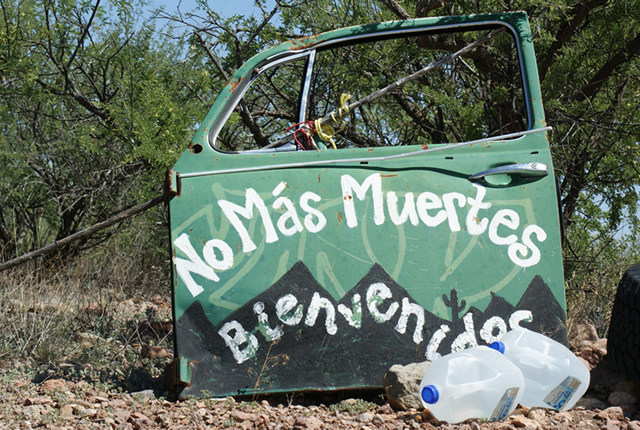
In this area, you come across a very heavy road, down a huge hill where water was washed out, and there’s no rest camp here. Some volunteers will go out in this part of the desert to put water on the trails for the migrants where possible.
If Joel had a magic wand, to improve the border situation, he would have the Border Patrol go after the Minutemen types. He would make sure the Border Patrol pays more attention to drug smugglers and the economic bankers behind them. It’s easy to catch the little guy who is not in good shape running to cross the desert because he wants to get a job in the U.S. making low wages to cook hamburgers. But meanwhile people in cities are able to suck all the drugs they want because the U.S. is not truly committed to ending the drug supply streaming through border areas.
In Joel’s view, something is very wrong with this situation.
Did You Enjoy This Hangout? Help Us Spread The Word!
If you liked what you heard here, and would like advance notice of our next immigration live hangout, please subscribe to us at Batara Immigration LIVE.
Thanks in advance, and if you have an idea or issue you would like us to address with a special guest, please let us know.
By Carlos Batara, Immigration Law, Policy, And Politics




